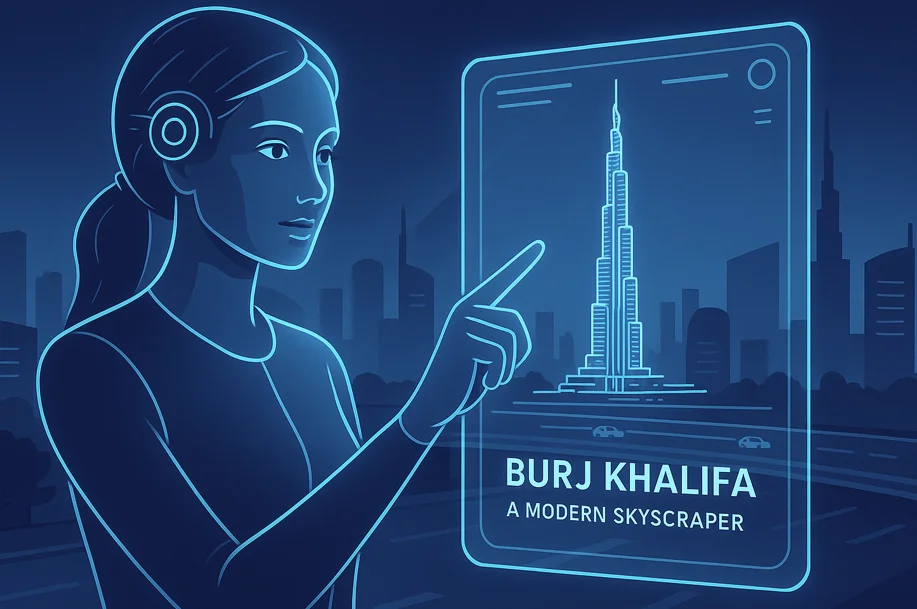🧠 Vision-Language Models in the UAE: Merging Sight and Text for Smarter AI
The UAE is rapidly advancing in artificial intelligence, with Vision-Language Models (VLMs) at the forefront. These models enable machines to process and interpret both visual and textual data simultaneously, leading to innovative applications across various sectors.
🇦🇪 UAE Use Cases: Where Sight Meets Intelligence
🚓 Smart Traffic Reporting – Dubai Police
Dubai Police has integrated AI into their traffic management systems to enhance efficiency. The AI analyzes minor traffic accidents and instantly issues reports to drivers without human intervention, streamlining the process and reducing congestion.
🔗 Dubai Police Implements AI
🏛️ Culture Meets AI – Louvre Abu Dhabi
The Louvre Abu Dhabi offers a mobile app featuring an "Art Scan" (Beta) function. Visitors can scan artworks to access detailed information in multiple languages, including Arabic and English, enhancing the museum experience through AI-driven insights.
🔗 Louvre Abu Dhabi
🛍️ Visual Search in Retail – Majid Al Futtaim
Majid Al Futtaim has launched AI-powered solutions to transform retail experiences. Their "Precision Media" platform uses AI to enhance customer engagement through advanced targeting and real-time analytics, redefining brand-consumer interactions.
🔗 Majid Al Futtaim’s
🌱 AI in Recycling – Expo City Dubai
Expo City Dubai is pioneering sustainable urban living by integrating AI into its waste management systems. The city employs AI to analyze waste streams, improving recycling efficiency and supporting its goal of achieving net-zero emissions by 2050.
🔗 Expo City Dubai Sustainability
🎓 Education & Research – MBZUAI
The Mohamed bin Zayed University of Artificial Intelligence (MBZUAI) is at the forefront of VLM research. The university has developed advanced models like GLaMM, enhancing the interaction between text and images, and contributing significantly to the field of AI.
🔗 MBZUAI Publishes 300 Papers in H1 2024
💡 Technical Snapshot: How VLMs Work
VLMs combine computer vision and natural language processing to interpret and generate content that encompasses both images and text. They are trained on datasets containing image-text pairs, enabling them to perform tasks such as:
- Image captioning
- Visual question answering
- Multilingual translation of visual content
- Visual reasoning and analysis
🔗 Hugging Face
These capabilities are being tailored in the UAE to accommodate Arabic language nuances and culturally relevant contexts, ensuring the technology aligns with local needs and values.
🌍 Multilingual and Culturally Aware
Recognizing the importance of cultural context, UAE initiatives are focusing on:
- Developing Arabic-language multimodal datasets
- Training models on local landmarks and cultural symbols
- Implementing ethical guidelines for AI content generation
These efforts ensure that VLMs are not only technologically advanced but also culturally sensitive and relevant.
🚀 What’s Next?
The integration of VLMs is expected to expand into various sectors, including:
- Healthcare: AI-assisted diagnostics and reporting
- Public Safety: Enhanced surveillance and emergency response
- Education: Interactive learning tools and resources
- Real Estate: Automated property descriptions and virtual tours
These advancements align with the UAE’s National AI Strategy 2031, positioning the country as a global leader in artificial intelligence.
🔮 Conclusion: Seeing the Future with VLMs
Vision-Language Models are revolutionizing the way we interact with technology in the UAE. By enabling machines to understand and interpret visual and textual information simultaneously, VLMs are enhancing efficiency, personalization, and accessibility across various sectors. As the UAE continues to invest in AI research and infrastructure, VLMs will play a pivotal role in shaping a smarter, more connected future.

Comments (0)
No comments yet. Be the first to share your thoughts!
Please log in to comment.